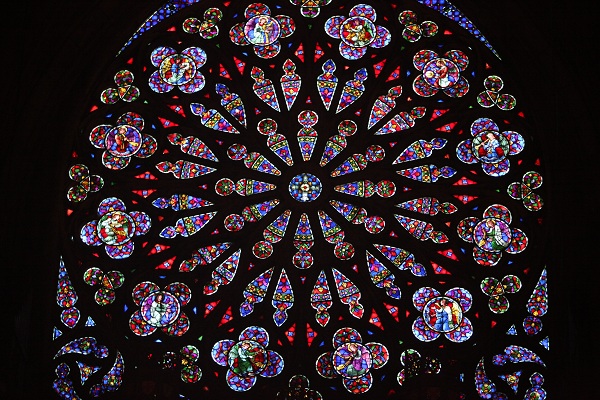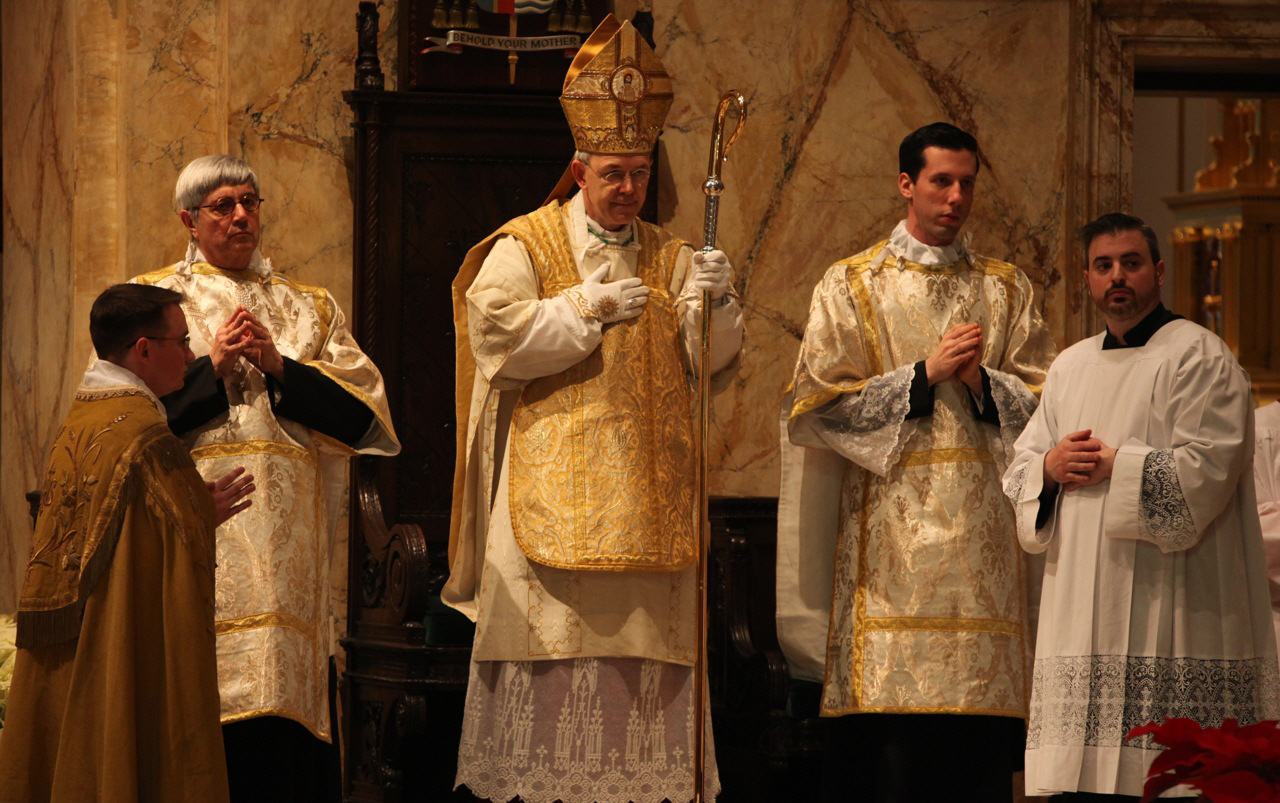
n.b. Fr. Sean Connolly has written an interesting article about the MacSwiney Chalice which will be used in this Mass. https://www.ncregister.com/blog/macswiney-chalice
29
May

n.b. Fr. Sean Connolly has written an interesting article about the MacSwiney Chalice which will be used in this Mass. https://www.ncregister.com/blog/macswiney-chalice
29
May
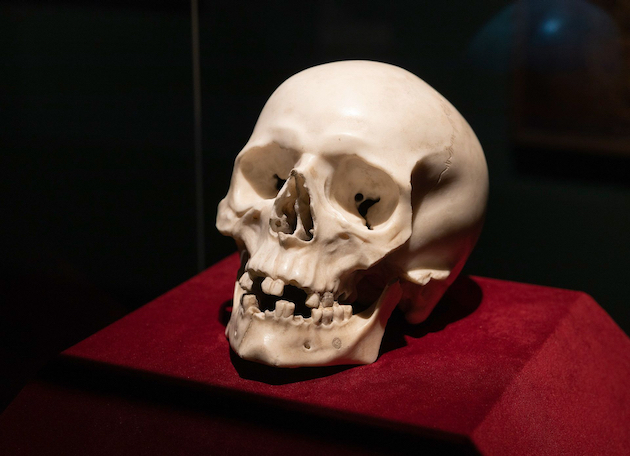
A Bernini marble sculpture of a skull rediscovered in Dresden – as described in Art News:
The artistic sensitivity of the baroque world was extraordinary! The marble skull was made for Pope Alexander VII around 1655. If you visit Dresden the skull can be viewed in an exhibition that has just opened. The gallery’s full description is here:
“In the seventeenth century, sudden and often violent death was omnipresent, which is why people were intensely preoccupied with mortality. A constant threat was posed not only by wars and assaults, but above all by diseases. In 1656 there was an outbreak of plague in Rome, and it is remarkable how closely the measures Alexander VII used to fight the epidemic (quarantine, masks, and the extensive shutting down of public life) resemble those that determine our everyday life in the face of the coronavirus today. Death, too, is again more prominent in people’s consciousness due to the current situation, and Bernini’s death’s head thus proves to be a memento mori of extraordinary topical relevance.“
(From the gallery’s description)
Actually, people “were intensely preoccupied with mortality” in almost all ages and cultures up to the dawn of Western Modernity, which has made a deliberate effort to suppress and marginalize the subject. A topic already incomparably set forth by Edgar Allen Poe in The Masque of the Red Death.
25
May
Such is the ordinary life of American Traditionalism today: organizing masses; establishing chapels, parishes and schools; finally, if possible, participating in conferences, public processions and pilgrimages, both in and outside of the United States. I had written in 2014, however, that to continue its progress, American Traditionalism needed to find its own saints and scholars – just as Europe did in the age of St. Patrick, St. Benedict, St. Boniface and so many others, when the Church converted both the disintegrating Roman world and the new barbarian nations.
In 2021 that need is even more dire. The great number of younger people newly introduced to Traditionalism requires liturgical, theological and historical instruction. Further, Traditionalists are compelled to explain and justify (as in the apologias for Christianity in pagan Roman times) their beliefs to an often hostile outside world. Finally, Traditionalism must develop a deeper understanding of its own origins and of how the Catholic Church got to the position it is in today. What is the intellectual and spiritual life of the Traditionalists – and what leaders have emerged?
I should start with the active, apostolic fraternities of priests, beginning with the Priestly Society of St. Pius X (FSSPX) founded by Archbishop Marcel Lefebvre. The FSSPX initiated the rebirth of the practice of Traditional Catholicism, both internationally and in the United States. The Fraternity has continued its steady progress in the last 8 years. In many respects a modus vivendi has been achieved with the Vatican, so the voices in America who continue to denounce the alleged schismatics have receded into the background. A grand new seminary was inaugurated five years ago in the state of Virginia to accommodate the growing number of young seminarians. The Fraternity also maintains its own chapels, schools and publications. On the other hand, the FSSPX has not taken a leading role in the debates on the Church and the world of the present day. Perhaps this more cautious public face is due to yet another recent schism within the Fraternity – that involving Bishop Williamson, which resulted in the formation within North America of the “SSPX – Marian Corps” (aka the “Resistance” or the “Strict Observance.”). Perhaps it reflects continued fond hopes of obtaining a more regular status from the Vatican.
The Priestly Fraternity of St. Peter (FSSP), an offspring of the FSSPX originating in resistance to Archbishop Lefebvre’s 1988 episcopal consecrations, also continues to make steady progress. I am told that their seminary, completed only in 2010, already cannot accommodate all the candidates. The FSSP principally staffs a network of parishes throughout the United States. I have otherwise heard very little from the Fraternity recently – quite a contrast with its prominence among Traditionalists in the decade after the 1988 Indult.
Recently, however, the most active of these priestly societies has been the Institute of Christ the King, Sovereign Priest (ICRSS or ICKSP). It perhaps has understood best the new opportunities available to Traditionalists under SP. Noteworthy is their outward, evangelical focus and a certain – shall we say – showmanship? The ICRSS, for example, pays close attention to the aesthetic details of the liturgy. It also specializes in taking over and restoring magnificent old churches abandoned by their dioceses because a loss of the congregation or the parish’s “bad neighborhood.”
Just in the last several years the Institute has made major inroads in Connecticut. In Waterbury (Hartford archdiocese) the ICRSS assumed the administration of the grand church of St. Patrick with enigmatic Irish-language inscriptions on the stained glass windows. In so doing, they have built upon and continued the celebration of the Latin Mass in that city – a tradition that in one form or another stretches back to 2007 and before. At almost the same time, the ICRSS took over a second church, Sts. Cyril and Methodius in Bridgeport (Bridgeport Diocese). An old Slovak church, Sts. Cyril and Methodius is situated in the midst of a virtual moonscape emblematic of American industrial and urban decay. But the church had been lovingly preserved by its long-term pastor who for decades celebrated an Indult Mass there for a small congregation. The Institute, building on these foundations, has awakened the parish to vigorous new life.
Yet perhaps the most heartening development is the resurgence of Traditionalist contemplative life. Has not the priority given historically to action over contemplation been a glaring defect not only of American Catholicism but of post-1830 ultramontane Catholicism in general? We might start our survey with the flourishing Clear Creek Abbey in Oklahoma (Our Lady of Clear Creek) which has been in existence since 1999 – back then I met on a transatlantic flight two monks returning to France from scouting out the location of the new monastery! An abbey since 2010, Clear Creek now has 50 monks and is engaged in a major building campaign. I have heard of families moving to that area in order to regularly attend the abbey’s services
Also representative are the Carmelite “Monks of the Most Blessed Virgin Mary of Mount Carmel” of Wyoming. These are cloistered contemplative monks- not mendicant friars. As to their liturgy, they state:
According to the Motu Proprio: Summorum Pontificum of His Holiness Pope Benedict XVI, and the corresponding Instruction Universae Ecclesiae, the Monks of the Most Blessed Virgin Mary of Mount Carmel have unanimously chosen to permanently retain the Carmelite Rite as the Liturgy of their institute according to the Carmelite liturgical books in use in 1962.
This monastery is also widely known for the brand of coffee it sells to support itself!
Of the female orders, perhaps the best known are the “Benedictines of Mary, Queen of the Apostles” in Gower Missouri. In 2018 the monastery was raised to an abbey and a new abbey church was consecrated. The ceremony for the consecration of their abbess, unique up till now in the United States, attracted wide attention. This monastery is also well known outside of just Catholic circles for its acclaimed, best-selling recordings of chant. Mention should also be made of a number of communities of Discalced Carmelites.
But two monasteries, located outside the United States but having many American members, have had perhaps the greatest resonance. Silverstream Priory in Ireland was founded in 2012 by Americans and erected as an autonomous monastery in 2017. The monks are widely known for their distribution of literature – some written by themselves. The monks appear, however, from recent reports to be having a rocky spell with the local ecclesiastical authorities.
The Traditional monastery of San Benedetto in Monte of Norcia, Italy, has acquired world fame. Their beer, Birra Nursia, has acquired a great reputation on these shores. Then there’s the heroic saga of the monks’ recovery, with the help of international donations, from the earthquake which destroyed their previous monastery. Their campaign to build a new monastery is ongoing. The greatest notoriety was achieved, however by the publication of Rod Dreher’s Benedict Option in 2017. The Norcia monks appear there as a model of a Christian community cultivating the interior life and withdrawing from the world. I don’t know about that – nor do I think Mr. Dreher had any real understanding of the specific liturgical foundation (Catholic Traditionalism) of this monastery’s life. What is clear, however, is that, thanks to the power of Catholic Tradition, a monastery like Norcia can almost immediately assume spiritual leadership – even in the secular world.
These examples illustrate the disproportionate influence of contemplative communities – among Traditionalists, other Roman Catholics and even the nonreligious. Primarily, of course it is their liturgies, prayers and chant which are transformative. And it seems that, just as in the days of the Benedictine monks of the “Dark Ages,” a host of secular benefits seem to flow from this spiritual foundation.
Another development, largely dating from 2013 and afterward, is the readiness of distinguished members of the hierarchy to regularly speak at Traditionalist conferences, to preside at ordinations in the Traditional form and to celebrate Traditional liturgies. Bishop Athanasius Schneider and Cardinal Raymond Burke are the most prominent – fearless defenders not just of the Traditional liturgy but of Catholic morality. Cardinal Burke and Cardinal Zen have also spoken on the tragic situation of the Church in China. We might add to this list the “underground” statements of Archbishop Vigano on the current state of the Church. It’s an array of public ecclesiastical advocates unimaginable just ten years ago. Of course, of the above, only Cardinal Burke is an American – but I could add the names of several supportive bishops in the United States who have offered public support to Traditionalists.
On the intellectual front, there have been definite gains in focus and understanding in the last eight years. In this realm, however, most people make little distinction between Conservatives, Traditionalists and, for that matter, others not Christian at all (like the French authors M. Onfray or M. Houellebecq). And isn’t one of the best analyses of the Novus Ordo Mass Work of Human Hands by the late Fr. Anthony Cekada (a sedevacantist)? Adherents of Traditionalism also regularly read the online publications of the Conservative Catholics that I have previously listed. Specifically Traditionalist sites of general interest – combining news, commentary, essays and politics – that can be added are Rorate Caeli and Onepeterfive.
The distinction between American and foreign authors is also relatively meaningless. It’s still a fact that American Traditionalism relies heavily on writers from Europe: Martin Mosebach, Roberto de Mattei, Aldo Maria Valli, Fr. Michael Fiedrowicz, Fr. Claude Barthe, Prof. Luc Perrin – to name some of the more prominent. Some of these authors’ works have been translated – much has not. It’s still a great advantage for a Traditionalist to be able to understand a number of foreign languages: French, German, Italian and Spanish, both in order to read the above-mentioned authors and also to follow numerous informative online publications in those languages (e.g., Le Forum Catholique)
This is not to say that the American and other English-speaking Traditionalists have been idle. Let me mention just a few names. Dr. Peter Kwasniewski has become a ubiquitous presence both as a speaker and a writer, primarily analyzing liturgical questions. Dr. John Lamont has written on a very scholarly level on theological, moral and philosophical issues of the past but also on the deviations of the contemporary. Church. Prof. John Rao, of course, has continued to explore history from a Traditionalist perspective as he has been doing for decades now. His Lake Garda conference (which will be held on Long Island this year) has served for many years as a forum for Traditionalists. It fulfills on the intellectual level much the same role that that the Chartres pilgrimage has done on the liturgical front. Finally, to this group we must of course add the online apostolate of Fr. John Hunwicke of England.
Let me give examples of specific topics that have received more careful consideration than had been the case in the past. New objects of inquiry are the Mass texts themselves: the readings, the orations, the Holy Week liturgies. Articles analyzing the Mass texts in detail have appeared on the popular sites New Liturgical Movement and Rorate Caeli. This research makes impossible, without significant further qualification, the former Traditionalist objective, so glibly asserted years ago, of merely restoring the “Latin Mass.” I should point out that the New Liturgical Movement (“NLM”) is now a venue where real knowledge is thoughtfully presented.
In similar vein, in the fields of theology and history, I might mention the growing realization that all was not well prior to 1958, that the foundations for the explosion of the Second Vatican Council were laid well before 1962. Indeed, the entire era characterized by 19th century ultramontanism (1846 – 1958) now appears, seen in perpective, in large part a preparation for the collapse of the 1960s. Some analyses of the roots of the Council go back much further than that. One again, it is no longer possible, without significant qualifications, to contrast the post-conciliar chaos with a pre-conciliar Eden.
A third, more abstruse, even exotic, topic is integralism. I have classified this movement in Part 1 of this essay as ”Conservative Catholic,” given its “papalist” orientation. From another point of view, however, integralism intersects with Traditionalism. For example, in advocating the subordination of the temporal to the spiritual power it directly clashes with the direction taken by the Second Vatican Council as well as with the neoconservative ideology of the “American experiment.” Now and then one even is reminded of Triumph magazine! The Josias, the movement’s website, features contributions by a number of Traditionalist “greats” covering a wide range of topics from the integralist perspective.
The foregoing presentation is of necessity incomplete.– I hope I will not have offended anyone left out! To form a complete list today of all monastic communities, Catholic intellectuals and websites would be a task greatly exceeding the scope of a short essay like this. My intent is, by giving representative examples known to me, to demonstrate that Traditionalism in America has progressed far beyond the stage of being content with just celebrating the Old Mass for a circle of initiates. It has become a broader force for general Catholic reform.
25
May
It is reported that Pope Francis has declared before the Italian bishops his intention of abolishing Summorum Pontificum, esssentially reinstating an indult regime.
See here. This is the original report (in Italian).
This apprears to be a reliable report.
UPDATE: A more detailed report (in French) from Paix Liturgique.
24
May
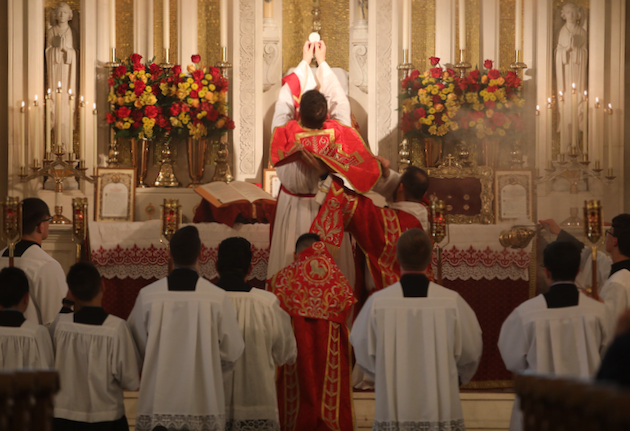
In this age of resurgent revolution, liquefying institutions and mounting fears, Traditional Catholicism has not fallen apart, but has continued to advance. This fact is no longer just an assertion by Traditionalists. The flourishing of Traditionalist life in the years since Summorum Pontificum (“SP”) has been noted with fear and rage – especially by the official Catholic media and the European clergy.
The new Traditionalist generation is indeed young and to a great extent includes growing families. And a new young generation of priest leaders has grown up as well. But what is really distinctive of Traditionalism today is that it is lived out in “stable groups of the faithful”– as mentioned in SP itself. Specifically in the United States, we have witnessed the emergence of fully formed SP parish life. And in contrast to the Indult regime – and the normal Novus Ordo parish, I should add – these communities now have an outward, not inward, focus.
We have seen that American Traditionalism emerged from the “underground” in the United States after the Indults of 1984/1988. Traditionalism since 1969 ( and really since 1964 ) had until then remained the one group within Catholicism that was officially and relentlessly persecuted. Its adherents had lived in small groups or in isolation. This is true both for those who frequented FSSPX chapels, those who attended the Masses of independent priests and those who followed Traditionalism more by reading about it. Of necessity, the Traditionalist community featured a great degree of individuality, not to say at times eccentricity and even dogmatism in questions of the faith and the liturgy. It was also true that the core of the Traditionalists at that time had known the old mass prior to the Council.
After the Indults, Traditionalists organized and formed groups to support the new Masses they were permitted to celebrate. In their new freedom and visibility they had to face a wide variety of issues they did not have to deal with in their prior existence as an underground resistance. For example, Traditionalists had to pay much more attention to the aesthetic aspect of their Masses. In some places greater care – almost unprecedented within the American Catholic Church in the previous decades – was now taken with music. I am thinking of the (still existing) St. Gregory Society of New Haven. And as the number of Masses celebrated in the United states increased, the number of new adherents increased as well , drawn from those who previously had never experienced the Traditional liturgy. A new generation was gradually taking over and transforming Traditionalism.
This demographic development was evident to me in the membership of the American contingent at the Chartres “Pilgrimage of Christendom” between the early 1990’s and 2010. On the first pilgrimage in which I participated the rather mature age (including my own!) of most of the American pilgrims was striking compared that of to the scouts who made up the bulk of the French contingents. Yet by 2010 that had changed – the American pilgrims were, on the whole, of the same average (youthful!) age as their European counterparts.
From 2007 onward, SP greatly accelerated these tendencies. The drastic restrictions of the Indult regime began to loosen. In many parish churches a Traditionalist community “moved in” as a new neighbor, the subject of continued distancing but also of curiosity. Previously existing independent chapels or venues for solitary indult Masses were absorbed and transformed by the new movement. Traditionalism also no longer meant celebrating just one Sunday Mass but providing all the sacraments in the Traditional form. As the number of Masses expanded, the congregations grew as well, as did the number of priests who wanted to celebrate the Traditional rite.
The result, in the most successful Traditionalist apostolates, was the appearance of the revived Traditionalist parish. Such a parish regularly celebrates the Solemn High Mass – or at least a Missa Cantata – on Sundays and major feast days. The community celebrates all the sacraments in the Traditional rite. A good number of young men to serve at the altar – indeed, as in the “good old days” scheduling is necessary. Music achieves an increasingly professional level – the vestments, decoration of the altar and other artwork compliment the level of the music. I have heard tell that one well known Traditionalist, recently deceased, had finally decided to become a Catholic just because of his new experience of singing chant in a SP parish. And there is a constant striving for perfection of the liturgy. The celebration of the pre-1955 Holy Week liturgies or the use of the folded chasuble were the province of a liturgical avantgarde ten years ago – now these practices are widespread and almost routine.
The consequences are quick to follow. From the ranks of the altar servers come vocations to the priesthood. The congregation continues to expand because of that unfailing rule: Catholic Traditionalism grows only by individual exposure to the old Mass. And in these expanded congregations social events – coffee hours, receptions, dinners, fundraising affairs – spontaneously spring up, linking the members of the community outside of liturgical celebrations. The contrast is astonishing between such a parish and even the most successful pre-2007 Indult groups.
Naturally I am describing a minority of exemplary communities. For much of American Traditionalism, life still revolves around a single Sunday Mass attended by small congregation. And many groups still cannot obtain even a regular Mass on Sunday. In a small, originally Italian parish not too far from where I live, a Saturday morning Mass has been started by a priest ordained 6 years ago. But as often as is humanly possible, his Saturday Mass is a Missa Cantata, celebrated with all the propers sung. That’s more than could be found in most of the well-attended High Masses of the pre-Conciliar days. The overall tendency is clear!
A great “penumbra” of Traditionalist life has also arisen outside of the totally committed Traditionalist communities. In the SP world, Traditionalists most often share a parish with other communities and rites. A fruitful interaction can result on this level – I have seen amazing combinations of the Traditional Liturgy with the Holy Week processions and other customs of Latin American Catholics. Some parishes celebrate a festive Traditional mass only on special occasions and holydays. Many grand churches otherwise not at all involved in the Traditionalist cause have opened their doors to an occasional Traditional liturgy – In New York, for example, St. Patrick’s cathedral( both old and new), St. Vincent Ferrer, Blessed Sacrament. St Jean Baptiste… . At least in our part of the country, quite a few bishops (and several visiting cardinals) celebrate the Traditional mass. And the reach of Traditionalism is even greater than this. So the Rorate Mass, an Advent liturgy celebrated in the darkness of early dawn, was revived not that long ago by Traditionalists. This custom has now spread to the Novus Ordo as well.
Now what do the Traditionalists believe? Obviously first and foremost is the celebration of the Traditional liturgy that has become the non-negotiable hallmark of Traditionalist Catholicism. But Catholic Traditionalists are in no way some kind of “papal” Anglo-Catholics. After all, the Traditionalist devotion to the Old Mass had to function for decades without the benefit of the – admittedly highly desirable – aesthetic features so essential to conservative Episcopalians. The celebration of the liturgy for Traditionalists, moreover, has been inseparable from full adherence to the theology and morality as expressed by Catholic tradition. From its very inception in the 1960s the Traditionalist movement made a forceful critique of the policies emerging from the Second Vatican Council: ecumenism, obsessive focus on dialogue, loss or denial of Catholic uniqueness, a conciliatory attitude to communism and leftism and toleration if not downright approval of moral deviations of every kind.
For the same reason, a Traditionalist community – even the most institutional, “normalized” examples – never can be just a Novus Ordo parish with the traditional liturgy, let alone a revival of its pre-conciliar predecessor. There is an interest and commitment to the intellectual, liturgical and moral questions of the day among the Traditionalists that sets them apart from their fellow Catholics. Not that traditionalist congregations are dominated by debates about theology, morality or the latest course the Vatican is taking – quite the contrary. Surveys have indicated, however, that among Traditionalist Catholics can be found higher level of knowledge of the Catholic faith – and certainly greater adherence to Catholic morality and the precepts of the Church.
It has been rightly pointed out that part of the reason for this American success story is the greater willingness of individual Catholics – both in the priesthood and among the laity– to take the initiative and work together to achieve objectives. For to this day there is no organization, religious congregation or publication providing centralized leadership and direction to the American Traditionalists. This does not mean that all Traditionalist Catholics have come to agree among themselves on all points – far from it. Yet they are mostly – not always – able to surmount those differences to cooperate for a supremely worthwhile cause.
The current American Traditionalist success story, of course, is also based on the fact that the same sense of pragmatism can be found among much of the American hierarchy. The average American bishop cannot afford to be as totally indifferent to Mass attendance, public relations or the morale of the laity in his diocese as are his European counterparts or the bureaucrats of the Vatican. From very early on, if only as a question of pragmatism, many bishops have shown themselves more or less willing to work with Traditionalists. Some have gone much further than that. We have experienced how bishops in our region repeatedly have intervened directly to remove obstacles to the Traditional liturgy raised by local pastors. They have permitted Traditional liturgies in their own cathedrals and in other major shrines and basilicas. Now and then a favorable mention of Traditionalism even appears in the official diocesan press (mirabile dictu!). It would be a mistake, therefore, to view the relationship between the hierarchy and Traditionalism as uniformly hostile – at least, I should repeat, in the New York area.
On the other hand, these same local ordinaries by no stretch of the imagination foster or encourage the spread of Traditionalism. Rather, in actual practice an arbitrarily enforced, restrictive policy of control prevails (especially as to the clergy). In some respects very little has changed from the Indult regime. As a matter of routine, Traditionalist priests are still summarily transferred from parishes and “exiled” to less attractive – and certainly far less visible – positions. For the local Traditionalist community that can mean termination of their liturgies if no like-minded successor is provided. The increasing number of young priests who choose traditionalism make an especially great sacrifice. As one Traditionalist priest recently said, there is no surer way of destroying your ecclesiastical career than declaring yourself in favor of the Old Mass. Other diocesan employees are similarly fearful of advertising Traditionalist sympathies.
This bias is also reflected in the allocation of diocesan resources. Traditionalists were entranced in 2020, for example, by a festive liturgy and conference that took place at St Vincent Ferrer church in New York City. And that was organized and funded by Traditionalists without direct support of the Archdiocese. Yet, on that very same weekend, the Archdiocese of New York sponsored a three day extravaganza with Communion and Liberation (the Italian “movement” originally aimed at students) featuring speakers, prelates and performers from all over the country. I think it is fair to say that Communion and Liberation has only a tiny fraction of the resonance that the Traditionalist movement enjoys either in the Archdiocese of New York or nationwide.
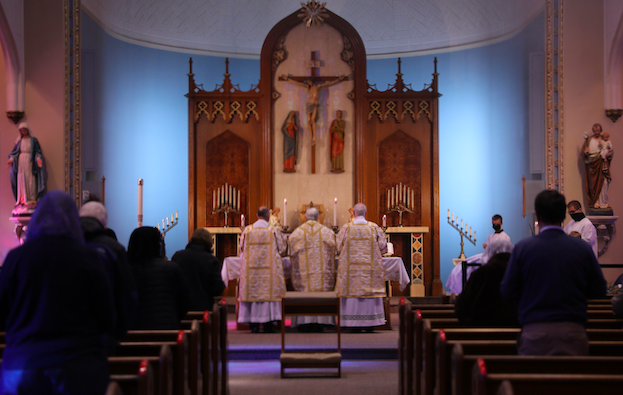




A beautiful Solemn Mass was celebrated at St. Joseph’s Church in Danbury, CT today. Fr. Michael Clark was the celebrant; Fr. Peter Lenox served as deacon and Michael Falvo, for his first time, served as sub-deacon.

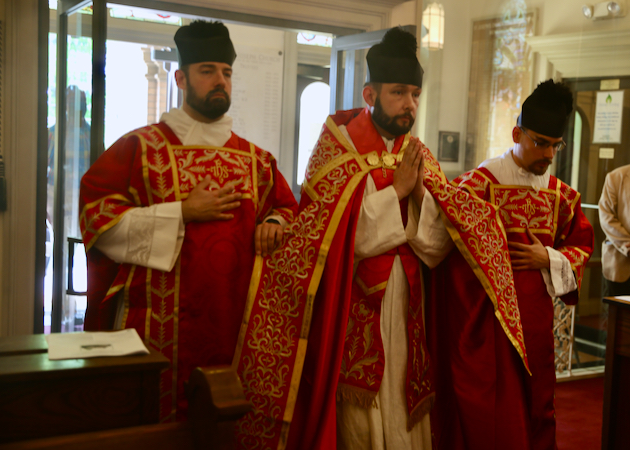
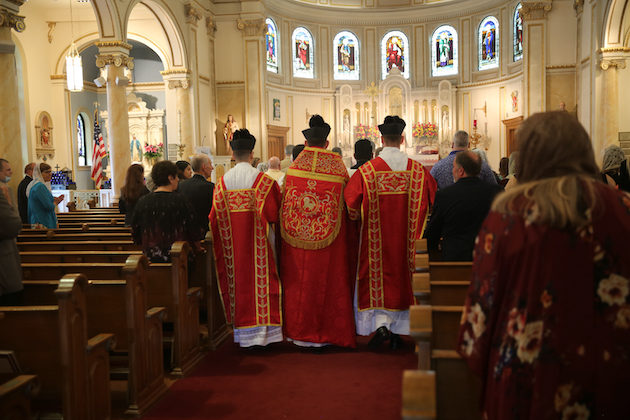
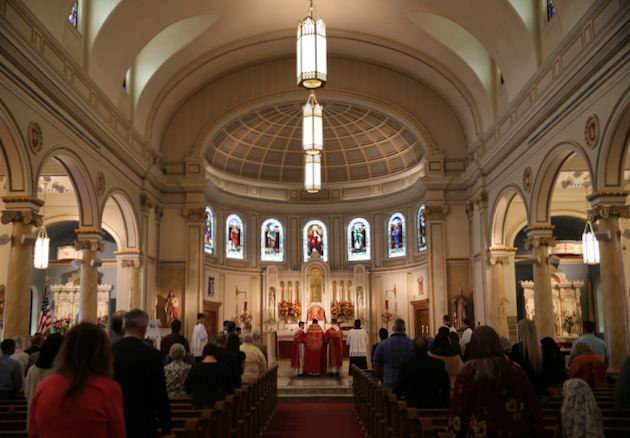

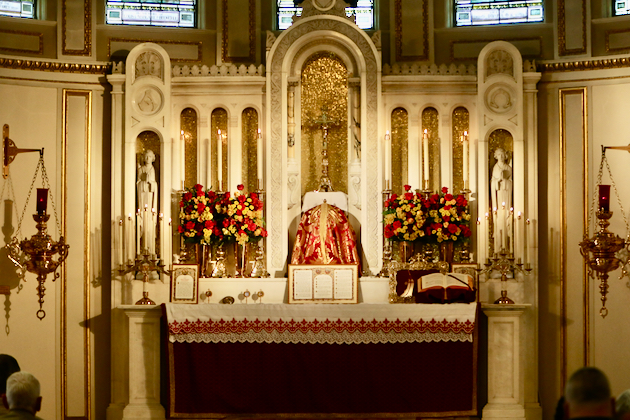

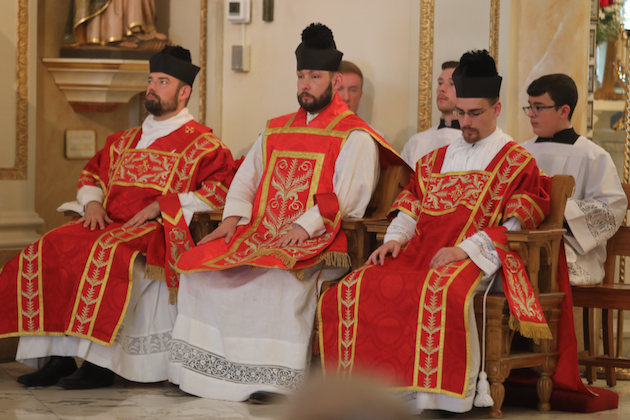
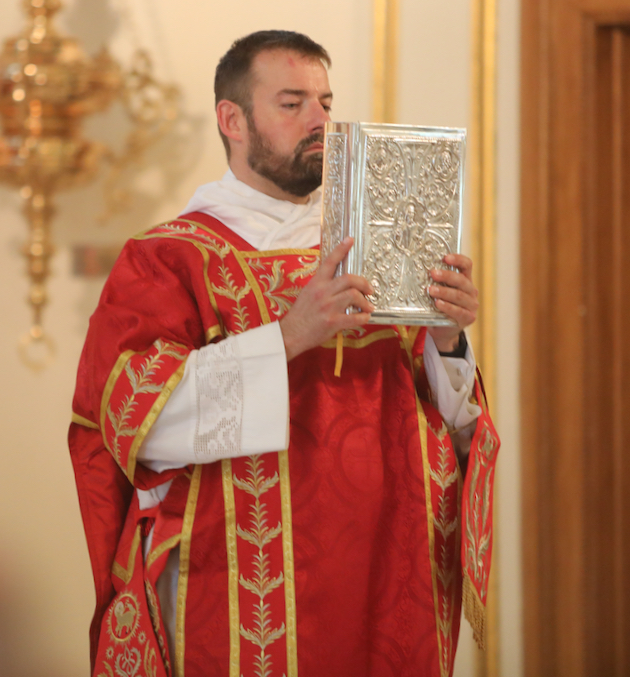




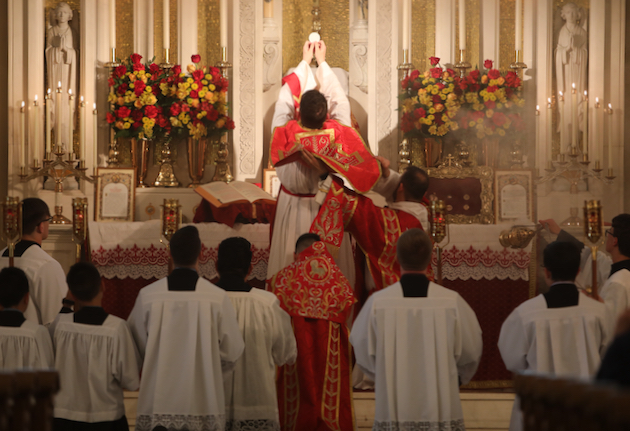


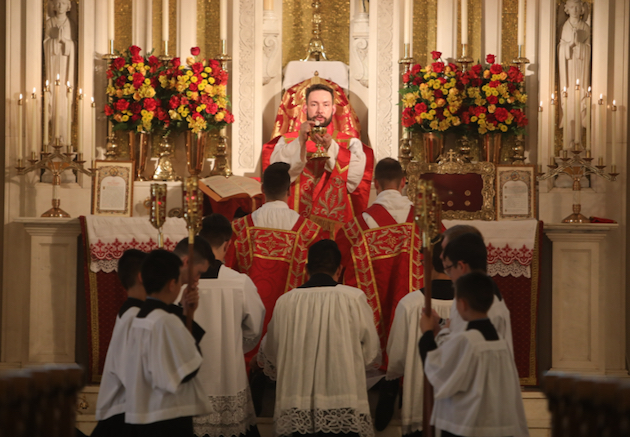
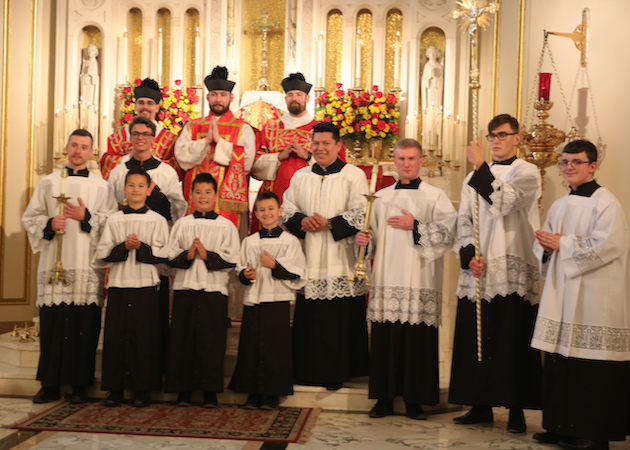
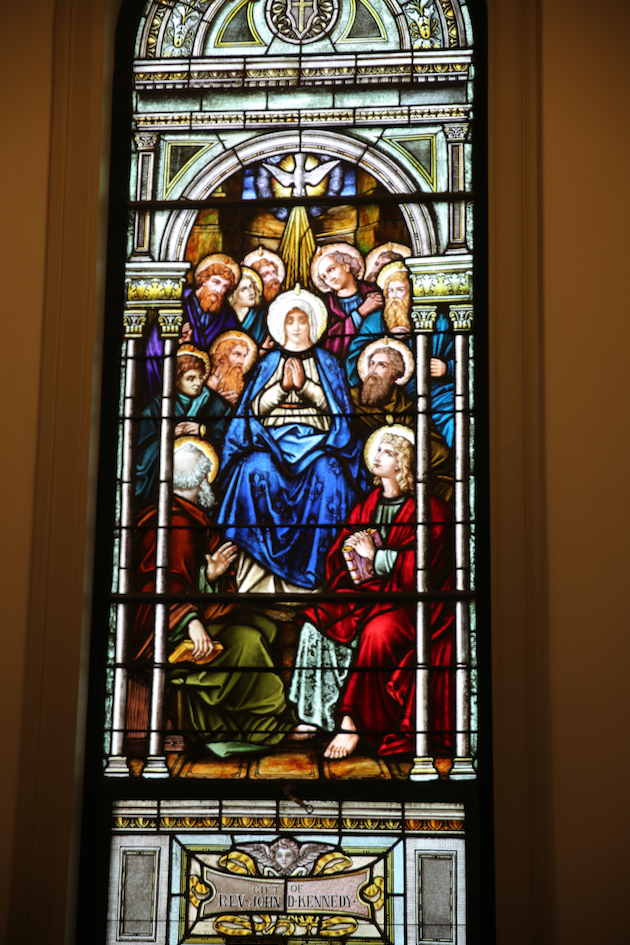
23
May
23
May

The peony is known as the Pfingstrose (Pentecost Rose) in German. For it blooms around the time of Pentecost – and its red blossoms match the liturgical colors of the day. This year, at least in the vicinity of New York, it has bloomed right on schedule.

22
May
21
May
There will be a Solemn High Mass at the Merchant Marine Academy on Saturday June 5, 2021, King’s Point, NY at 10:00 am for the Feast of St. Boniface, Apostle of Germany.
Fr. Donald Kloster, Celebrant, Fr. Michael Novajosky Priest Deacon, Fr. Sean Connolly Priest Subdeacon, Mr. Bill Riccio, Master of Ceremony.
Mr. David Hughes, Mr. David Indyk, and the Viri Galilaei will chant the Mass.
